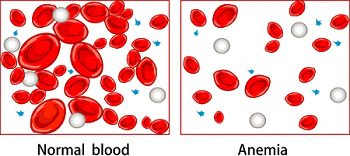Anaemia Remedy Tincture 50ml
Traditionally used for anemia, weak blood production and iron deficiency
Learn More
Compilation proportions:
Nettle – 14,3%
Burdock – 14,3%
Dandelion Root – 14,3%
Gentian – 14,3%
Parsley – 14,3%
Yellow Dock – 14,3%
Alfalfa – 14,3%
Suggested dosage:
20 drops in a little water 2-3 times per day.
In acute cases take every hour
Further Information:
Anaemia is a decrease in the ability of blood to carry oxygen. This occurs because there is a reduction in the number of red blood cells or because the amount of haemoglobin they contain is low. Haemoglobin is a pigment contained within the red blood cells that bind to oxygen. Anaemia is one of the most common blood conditions and can affect all age groups, it is more common in females than males

Underlying Emotions:
Feeling stuck in flight or fight mode.
Unresolved generational traumas, Lack of joy, Fear of life, Not feeling good enough. Feeling emotionally drained
Symptoms:
The symptoms of anaemia may depend on its cause. In blood loss, the following are commonly experienced:
1. Faintness
2. Dizziness
3. Thirst
4. Cold sweat
5. Fast or unusual heartbeat (tachycardia)
6. Shortness of breath
7. Shock, and death if the blood loss is severe and untreated.
With iron deficiency anemia:
1. Dizziness
2. Lightheadedness, or feeling faint,
3. A fast or unusual heartbeat
4. Headache
5. Pains in the bones, chest, belly, and joints
6. Shortness of breath
7. Skin that’s pale or yellow
8. Cold hands and feet
9. Tiredness or weakness,
10. Pica (craving dirt or paint) or pagophagia (craving ice)
In vitamin B12 deficiency:
1. Anorexia
2. Occasional constipation
3. Diarrhea
4. Vague abdominal pain
5. Glossitis (burning of the tongue)
6. Neurological involvement especially peripheral nerves (tingling in the fingers and toes) may occur
Folic-acid-related anemia is similar to B12 deficiency with the exception of the neurological symptoms
Vitamin C deficiency anemia: signs of scurvy (bleeding gums, easy bruising, frequent illnesses, nosebleeds, slow healing) will be present
Suggested remedials
Please note: Ensure that a blood test is done to confirm anaemia before taking supplementation.
Excess iron in supplementation may damage the liver, heart, and pancreas.
Don’t take Calcium, Vitamin E, Zinc, or antacids with iron supplements as these may affect the absorption of iron
1. Diet and supplementation will be key to combat deficiencies in iron and B12-related anaemias
2. Intravenous ozone therapy may be beneficial.
Nutrients and supplements:
1. Blackstrap molasses – consuming Blackstrap molasses on a daily basis will be beneficial as it contains iron and B vitamins.
2. Anaemia remedy – used for anemia, weak blood production, and iron deficiency.
3. Iron & Folic acid – to restore iron and for the formation of red blood cells
4. Iron – restores iron
5. Folic acid – for the formation of red blood cells
6. Vitamin E – prolongs the life of red blood cells
7. Buffered vitamin C – assists with iron absorption
8. Vitamin B6 – aids in the absorption of vitamin B12
Causes:
Anaemia may result from the following:
1. Blood loss, deficient iron, B12, folic acid, copper, and vitamin C, a genetic predisposition, or a serious disease or condition such as (Sickle cell anaemia). With blood loss (hemorrhage) external, internal, or prolonged menses bleeding will decrease the oxygen-carrying capacity of the blood.
2. Iron-deficiency anemia: (the most common type of anemia). Hemorrhage must be ruled out in any adult presenting with iron deficiency anemia. Pregnancy causes anemia in women, as does prolonged heavy menses. In men, slow gastrointestinal bleeding may be the primary cause.
3. With vitamin B12 deficiency (pernicious anemia): B12 stored in the liver is diminished and is eventually unable to sustain an individual. The anemia typically develops over time as the B12 stores are depleted. Vegans have a greater risk for B12 deficiency since the most significant sources of B12 are found in animal products.
4. Folic-acid-related anaemia often results from poor dietary intake. Liver stores are only sufficient for only 2-4 months where there is a deficiency. Absorption of folic acid is decreased by alcohol, intestinal malabsorption issues, oral contraceptives, and anticonvulsants.
5. Anemia is also often associated with a vitamin C deficiency.
How diet may assist:
1. Omitting all sugar from the diet will increase the absorption of iron.
2. Foods containing heme iron: (Note: Iron in the heme form is better absorbed) Clams, poultry (chicken, turkey, ostrich), beef, tuna, oysters, mussels.
3. Nonheme iron: Beetroot greens, green vegetables, pumpkin seeds, lentils, potato, tofu, kidney beans. black beans, green beans, black cherries, apricots, blackberries, apples, currants, egg, kelp, lettuce, prunes, spinach, huckleberries, peach, molasses, mustard greens, nettles, mulberries, parsley, liver, watercress.
4. Foods containing B12: Meat, Poultry and Fish, brewers yeast, soy milk, cornflakes, blackstrap molasses. Strict vegetarians and vegans need to be mindful of their diet, taking supplemental vitamin B12 is advised.
5. Eating fish together with iron-rich vegetables increases iron absorption.